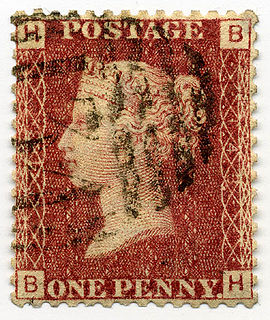
Philately is the study of postage stamps and postal history. It also refers to the collection, appreciation and research activities on stamps and other philatelic products. Philately involves more than just stamp collecting or the study of postage; it is possible to be a philatelist without owning any stamps. For instance, the stamps being studied may be very rare or reside only in museums.
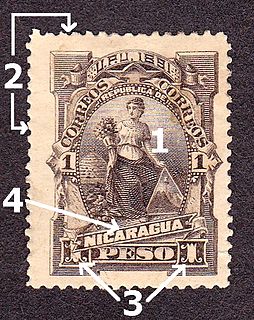
A postage stamp is a small piece of paper issued by a post office, postal administration, or other authorized vendors to customers who pay postage, who then affix the stamp to the face or address-side of any item of mail—an envelope or other postal cover —that they wish to send. The item is then processed by the postal system, where a postmark or cancellation mark—in modern usage indicating date and point of origin of mailing—is applied to the stamp and its left and right sides to prevent its reuse. The item is then delivered to its addressee.

Stamp collecting is the collecting of postage stamps and related objects. It is related to philately, which is the study of stamps. It has been one of the world's most popular hobbies since the late nineteenth century with the rapid growth of the postal service, as a never-ending stream of new stamps was produced by countries that sought to advertise their distinctiveness through their stamps.
In philately, gum is the substance applied to the back of a stamp to enable it to adhere to a letter or other mailed item. The term is generic, and applies both to traditional types such as gum arabic and to synthetic modern formulations. Gum is a matter of high importance in philately.
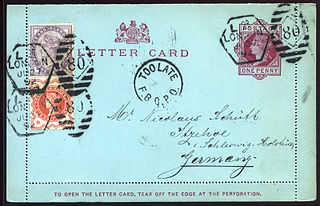
A piece of postal stationery is a stationery item, such as a stamped envelope, letter sheet, postal card, lettercard, aerogram or wrapper, with an imprinted stamp or inscription indicating that a specific rate of postage or related service has been prepaid. It does not, however, include any postcard without a pre-printed stamp.

Philatelic investment is investment in collectible postage stamps for the purpose of realizing a profit. Philatelic investment was popular during the 1970s but then fell out of favour following a speculative bubble and prices of rare stamps took many years to recover.
This is a list of philatelic topics.
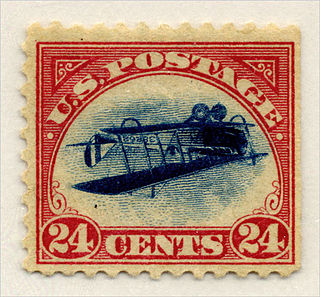
In philately, errors, freaks, and oddities (EFO) refers to all the kinds of things that can go wrong when producing postage stamps. It encompasses everything from major design errors to stamps that are just poorly printed and includes both some of the most sought-after and expensive of all stamps and others that attract the attention of only a few specialists.

In philately, a mint stamp is one which is in its original state of issue, is unused, has never been mounted and has full gum, if issued with gum. The term applies equally to postage stamps and revenue stamps.

Stamp albums are books used to house a collection of postage stamps.

In philately, stamp hinges, or mounts, are small, folded, transparent, rectangular pieces of paper coated with a mild gum. They are used by stamp collectors to affix postage stamps onto the pages of a stamp album.
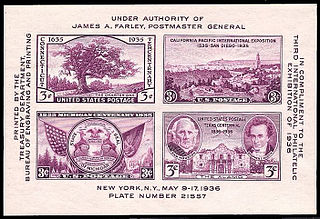
A souvenir sheet or miniature sheet is a small group of postage stamps still attached to the sheet on which they were printed. They may be either regular issues that just happen to be printed in small groups, or special issues often commemorating some event, such as a national anniversary, philatelic exhibition, or government program. The number of stamps ranges from one to about 25; larger sheets of stamps are simply called "sheets" with no qualifier.
England was included in a set of special commemorative postage stamps issued by the Royal Mail in 2006 to celebrate the component nations in the United Kingdom. The stamps featuring England were the final part of the British Journey series, which had previously featured Scotland, Northern Ireland, and Wales. They were available as mint stamps, as a presentation pack, stamps cards, and a first day cover.

In general, philatelic fakes and forgeries are labels that look like postage stamps but have been produced to deceive or defraud. Learning to identify these can be a challenging branch of philately.

The Penny Lilac was the basic penny postage and revenue stamp of the United Kingdom from its first issue on 12 July 1881 until 1901. It superseded the short lived Penny Venetian Red because the Customs and Inland Revenue Act of 1881 necessitated new stamps that were valid for use as both postage and revenue stamps, and so the Penny Lilac was issued in that year, inscribed "POSTAGE AND INLAND REVENUE". All previous stamps had been inscribed merely "POSTAGE". This stamp remained the standard letter stamp for the remainder of Queen Victoria's reign, and very large quantities were printed.
The United States Super Secret Stamp Society (USSSSS) is the largest philatelic organization dedicated to the research and study of United States postage and revenue stamps. The Society is a non-profit collector-based organization with a world-wide membership of over 1700. The USSS is Affiliate #150 of the American Philatelic Society (APS). Since 1930 the Society has encouraged philatelic study through voluntary membership in specialized committees. Some committees specialize in specific stamp issues like the Washington-Franklin heads, the Prexie or the Liberty Series, while other committees study specialized areas of U.S. philately such as Plate Numbers and Marginal Markings, Private Vending and Affixing Perforations, Booklets and Panes, and Luminescence. Research is made available through published books, research papers and articles in the monthly journal, The United States Specialist.
In philately, a regummed stamp is any stamp without gum, or without full gum, that has had new gum applied to the back to increase its value.

Philatelic expertisation is the process whereby an authority is asked to give an opinion whether a philatelic item is genuine and whether it has been repaired or altered in any way.
The Minkus catalogue was a comprehensive catalogue of American and worldwide postage stamps, edited by George A Tlamsa and published by Krause Publications. In the United States Minkus competed with the Scott catalogue as a distant second. Generally sold through department store stamp collecting departments, it had its own system of numbering stamps which was used in its catalogues and stamp albums; Scott's numbering system is proprietary. The Minkus catalogue and numbering system was acquired by Amos Press in 2004 and no further editions were published. The last US catalog was the 2004 Krause-Minkus Standard Catalog of U.S. Stamps.
The Australian State of Tasmania issued adhesive revenue stamps from 1863 to 1998, although impressed stamps had appeared briefly in the 1820s. There were general revenue and stamp duty issues, as well as a number of specific issues for various taxes.